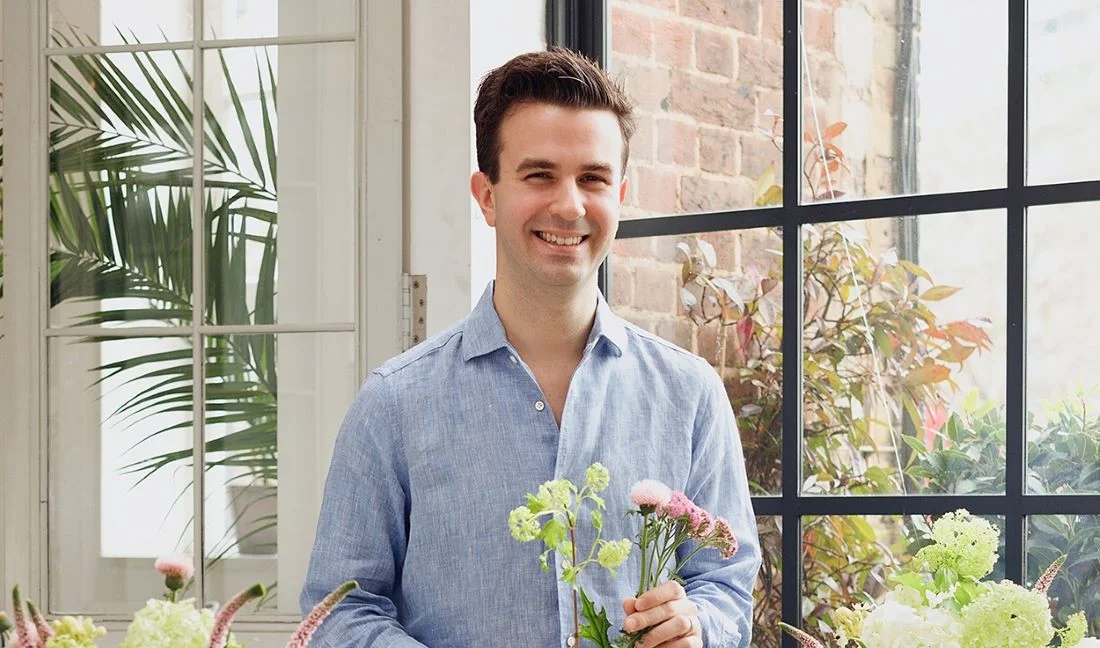
Founded in 2013 by Aron Gelbard and Ben Stanway, Bloom & Wild has seen its business significantly increase its year-on-year turnover. Currently, the company is on track to more than triple revenues over the last three years.
This rapid expansion has made Bloom & Wild the European leader in online flower delivery. Last year, the company completed two major international acquisitions as part of its growth strategy and doubled the number of countries it is operating in – expanding from four at the start of 2020 to eight at the end of 2021.
Inspiration
A culmination of family influence and the amalgamation of skills acquired throughout his career led Gelbard (now Bloom & Wild’s CEO) to start the company.
He comments, “I set up the company nine years ago, with a view to trying to make flowers the joy that I think they should be. I come from a family of entrepreneurs. My dad is an entrepreneur and has been for 50 years. Three of my four grandparents set up their own businesses as well. So, being an entrepreneur was always something that I hoped to do.
“I worked for the first eight years of my career as a management consultant with consumer products, retail, and tech companies. Through this, I became really interested in e-commerce and direct-to-consumer (D2C) business models.
“It was from this point that I started to think about setting up my own business in that area, but I was really motivated to do something which I thought was going to create brilliant consumer experiences and generate positive feedback on an emotional level. That is what really drew me to the flower industry.
“It was through this combination of feedback and personal desire, mixed with the fact that the industry satisfaction levels were low – nobody was innovating within the flower industry. It is such an emotive product, which is what made me feel that this was a great place to get started on my entrepreneurial journey.”
Disruptive force
It was this mix of entrepreneurial intrigue and an understanding of the revolution that was impacting the retail sector, the team at Bloom & Wild saw an opportunity to kickstart a rapid change within the D2C market.
Gelbard explains, “Nobody had built technology that was bespoke to the flower industry. I’d seen people in other industries building out technology solutions that were solving customer problems. A couple of examples of this would be Graze, The Snack Box Company and Gousto. It felt like lots of other industries were using technology to build better customer experiences, but that hadn’t made it to the flower industry.
“The industry also suffered from challenges in the supply chain. Flowers will regularly pass through six to seven middlemen between being grown on a farm somewhere around the world to making it to the kitchen table of the recipient. Each of those middlemen will add cost, use up valuable vase life, and also be responsible for some of the waste in our supply chain, which can regularly be as high as 40%.
“The result of all this is that flowers can be expensive, they cannot last very long, and they can have a poor environmental impact. So, our solution here was to try and build relationships directly with growers and avoid going through lots of middlemen, to both bring down the cost, reduce waste and, therefore, be able to be attractively priced for consumers. The aim was that they’d then be repeat customers, who would drive our growth.”
Keys to growth
Aside from disrupting the status quo within the flower industry, there have been many key factors that have led to Bloom & Wild being able to successfully scale.
Gelbard comments, “In order to sustain our levels of growth, we’ve invested heavily in our tech and data team, which is now almost 100 strong across our group – we are on a very different scale to anybody else in the industry. As a result of that, we’ve had the capacity to run hundreds of A/B tests to figure out how to make the consumer experience as strong as possible.
“We are not just trying to increase conversion rate, but we’re also trying to make sure that we’re giving customers a better experience with anything that we add or change to the business. At a consumer-facing level, we have built an app that allows you to order flowers in as little as 10 seconds. We’ve built automated occasion reminders so that people can save occasions and recipients, be easily reminded of them and be able to check out in a couple of taps of your screen.”
With everything in place to continue its growth trajectory, March 2020 came along and changed the business landscape for every company in the UK. However, the series of lockdowns and restrictions put in place by the Government actually led to further success for Bloom & Wild. And due to their pursuit of customer satisfaction, this has given them the platform to continue expanding in the years ahead.
Gelbard continues, “We have seen particularly strong demand during periods of lockdown, where people are not able to see their loved ones in person, and flowers end up being a substitute for a hug. As we have maintained our strong customer satisfaction scores during those periods, we have seen that the customers who tried us for the first time during lockdown periods have ended up being repeat customers and continue to shop with us today.
“So, we have not just seen the short-term growth during the pandemic, we have seen sustained growth that has lasted beyond the lockdowns. And as a result, Bloom & Wild has more than doubled in size over the last two years.”
Growth through acquisitions
Alongside Bloom & Wild’s success in the domestic market, and its ability to scale through the utilisation of new tech and implementing a new style of supply chain – the company has also achieved growth through acquisitions and funding rounds.
In total, the retailer has raised more than £100m over multiple rounds, involving angel investors, institutional investors and global venture capital firms who have a history in the D2C space. This includes MMC, Burda Principal Investments, Piper, General Catalyst and Index Ventures.
Gelbard comments, “I believe having these really strong investors has helped us accelerate our growth, and we have been able to use this much larger amount of money to be in a position to make international acquisitions. The funding has enabled us to scale at pace.”
The company had already started operating in Germany a few years ago and had seen similar success compared to the UK, due to the same lack of innovation within the D2C market. Following this, the company made its first acquisitions.
Gelbard explains, “About 18 months ago, as we were thinking about further international expansion, we reflected that, in addition to doing this organically, it may make sense to expand internationally through acquisition. We did this for a couple of reasons. Firstly, flowers are a very emotive product that people often want to buy from local brands that they feel a degree of trust and affinity for.
“Secondly, we have a goal to build the world’s leading and most-loved flower company, and we thought that we’d be able to achieve that goal more rapidly if we were able to bring other companies into our group, where we had a shared philosophy around the products, a more efficient supply chain, better use of technology and really delighting customers with what we do.”
Last year, Bloom & Wild acquired Netherlands-based Bloomon and French competitor Bergamotte.
He continues, “In the case of Bloomon, they were a subscription-based platform and we have been looking to try and grow flower subscriptions. They have also invested heavily in their supply chain, they have relationships with around 200 growers around the world – and they have the technology to manage that. They have a state-of-the-art production facility outside Amsterdam, where they’re based, which is a European flower hub.
“Regarding Bergamotte, they’ve got a brilliant brand within the French market, and they also are experts in plants, which is close to half their business. This is an area that we’re trying to grow at Bloom & Wild. They’ve also done a lot of work with physical retail, in addition to online, which is another area that we’re interested in exploring. By adding growth through acquisition to organic growth, we’ve been able to bring new capabilities into our group.”
Overcoming challenges
Despite its success at home and abroad, Gelbard has had to face a series of difficulties on the company’s journey over the last nine years.
He comments, “Raising funding with the right investors is incredibly challenging. We have spent a lot of time making sure we are doing the right thing for our business. This is especially true when you come to raise the larger sums, as the investors become very exacting with the results of the money, and you then need to deliver. They want answers to a lot of questions and really want to understand both your traction and your vision for the future – and how exactly you are to achieve the levels of growth they expect.”
All across the retail sector, one of the universal challenges facing almost every business is related to the ongoing supply chain crisis. Despite the issue, the company has adapted to the situation, meaning it has been able to thrive under pressure and help the flower industry survive the pandemic.
Gelbard continues, “During the first lockdown, when we saw increased demand very rapidly, we were able to work with our supply partners to ramp up the number of flowers we could source. This was also a favour to many of our growth partners because a lot of supermarkets were selling fewer flowers and thousands had already gone to waste. Therefore, we were able to take on some of that excess volume. We have been able to continue to make sure that we have a reliable supply from multiple sources, despite all of the disruption.”
Future plans
By weathering the storm of COVID-19, expanding internationally, and having a reliable supply chain, Bloom & Wild has positioned itself for a bright future.
Last year, the company launched a subscription service, which is set to expand in the range of products it will offer and to new customers – utilising the two acquired businesses.
The other goal for Gelbard is for Bloom & Wild to ‘experiment’ with physical retail concepts, to work alongside its digital offering. This follows the company’s recent launch in over 140 Sainsbury’s stores.
He concludes, “There are so many opportunities to continue to scale our business in the UK and Europe, especially having made these acquisitions. I am really motivated to continue to build this company for many years.”
Related and recommended
The auto industry entrepreneur believes smart pivots can be the start button to fire up business success
Knowing how to get agreement between two parties is key in business. Two experts who have dealt with life-and-death negotiations offer their insight
The hotel executive believes the hospitality industry needs to be proactive in hiring to reflect society
The legendary ad exec believes leaders should collaborate with the technology, rather than use it as a tool

